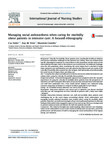Managing social awkwardness when caring for morbidly obese patients in intensive care: A focused ethnography.
| dc.contributor.author | Hales, C | en |
| dc.contributor.author | de Vries, K | en |
| dc.contributor.author | Coombs, M | en |
| dc.date.accessioned | 2018-12-16T14:31:13Z | |
| dc.date.available | 2018-12-16T14:31:13Z | |
| dc.date.issued | 2016-06 | en |
| dc.identifier.uri | http://hdl.handle.net/10026.1/13064 | |
| dc.description.abstract |
BACKGROUND: Critically ill morbidly obese patients pose considerable healthcare delivery and resource utilisation challenges in the intensive care setting. These are resultant from specific physiological responses to critical illness in this population and the nature of the interventional therapies used in the intensive care environment. An additional challenge arises for this population when considering the social stigma that is attached to being obese. Intensive care staff therefore not only attend to the physical and care needs of the critically ill morbidly obese patient but also navigate, both personally and professionally, the social terrain of stigma when providing care. AIM: To explore the culture and influences on doctors and nurses within the intensive care setting when caring for critically ill morbidly obese patients. DESIGN AND METHODS: A focused ethnographic approach was adopted to elicit the 'situated' experiences of caring for critically ill morbidly obese patients from the perspectives of intensive care staff. Participant observation of care practices and interviews with intensive care staff were undertaken over a four month period. Analysis was conducted using constant comparison technique to compare incidents applicable to each theme. SETTING: An 18 bedded tertiary intensive care unit in New Zealand. PARTICIPANTS: Sixty-seven intensive care nurses and 13 intensive care doctors involved with the care and management of seven critically ill patients with a body mass index ≥40kg/m(2). FINDINGS: Interactions between intensive care staff and morbidly obese patients were challenging due to the social stigma surrounding obesity. Social awkwardness and managing socially awkward moments were evident when caring for morbidly obese patients. Intensive care staff used strategies of face-work and mutual pretence to alleviate feelings of discomfort when engaged in aspects of care and caring. This was a strategy used to prevent embarrassment and distress for both the patients and staff. CONCLUSIONS: This study has brought new understandings about intensive care situations where social awkwardness occurs in the context of obesity and care practices, and of the performances and behaviours of staff in managing the social awkwardness of fat-stigma during care situations. | en |
| dc.format.extent | 82 - 89 | en |
| dc.language | eng | en |
| dc.language.iso | eng | en |
| dc.rights | Attribution-NonCommercial-NoDerivatives 4.0 International | en |
| dc.rights | Attribution-NonCommercial-NoDerivatives 4.0 International | en |
| dc.rights | Attribution-NonCommercial-NoDerivatives 4.0 International | en |
| dc.rights | Attribution-NonCommercial-NoDerivatives 4.0 International | en |
| dc.rights | Attribution-NonCommercial-NoDerivatives 4.0 International | en |
| dc.rights | Attribution-NonCommercial-NoDerivatives 4.0 International | en |
| dc.rights.uri | http://creativecommons.org/licenses/by-nc-nd/4.0/ | en |
| dc.rights.uri | http://creativecommons.org/licenses/by-nc-nd/4.0/ | en |
| dc.rights.uri | http://creativecommons.org/licenses/by-nc-nd/4.0/ | en |
| dc.rights.uri | http://creativecommons.org/licenses/by-nc-nd/4.0/ | en |
| dc.rights.uri | http://creativecommons.org/licenses/by-nc-nd/4.0/ | en |
| dc.rights.uri | http://creativecommons.org/licenses/by-nc-nd/4.0/ | en |
| dc.subject | Focused ethnography | en |
| dc.subject | Intensive care | en |
| dc.subject | Medicine | en |
| dc.subject | Morbid obesity | en |
| dc.subject | Nursing | en |
| dc.subject | Qualitative research | en |
| dc.subject | Social awkwardness | en |
| dc.subject | Anthropology, Cultural | en |
| dc.subject | Attitude of Health Personnel | en |
| dc.subject | Humans | en |
| dc.subject | Intensive Care Units | en |
| dc.subject | Nurse-Patient Relations | en |
| dc.subject | Obesity, Morbid | en |
| dc.subject | Physician-Patient Relations | en |
| dc.subject | Social Behavior | en |
| dc.title | Managing social awkwardness when caring for morbidly obese patients in intensive care: A focused ethnography. | en |
| dc.type | Journal Article | |
| plymouth.author-url | https://www.ncbi.nlm.nih.gov/pubmed/27087301 | en |
| plymouth.volume | 58 | en |
| plymouth.publication-status | Published | en |
| plymouth.journal | Int J Nurs Stud | en |
| dc.identifier.doi | 10.1016/j.ijnurstu.2016.03.016 | en |
| plymouth.organisational-group | /Plymouth | |
| plymouth.organisational-group | /Plymouth/REF 2021 Researchers by UoA | |
| plymouth.organisational-group | /Plymouth/REF 2021 Researchers by UoA/UoA03 Allied Health Professions, Dentistry, Nursing and Pharmacy | |
| dc.publisher.place | England | en |
| dcterms.dateAccepted | 2016-03-23 | en |
| dc.identifier.eissn | 1873-491X | en |
| dc.rights.embargoperiod | Not known | en |
| rioxxterms.versionofrecord | 10.1016/j.ijnurstu.2016.03.016 | en |
| rioxxterms.licenseref.uri | http://creativecommons.org/licenses/by-nc-nd/4.0/ | en |
| rioxxterms.licenseref.startdate | 2016-06 | en |
| rioxxterms.type | Journal Article/Review | en |



